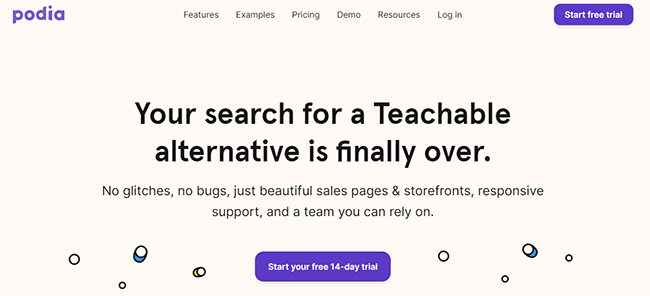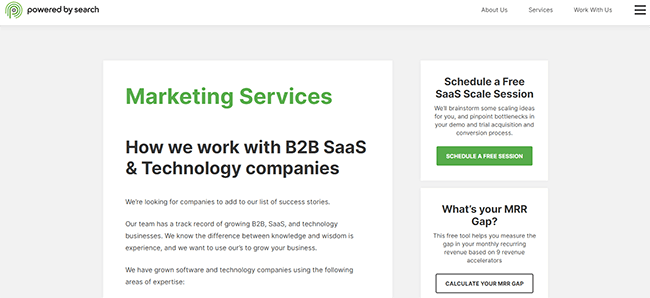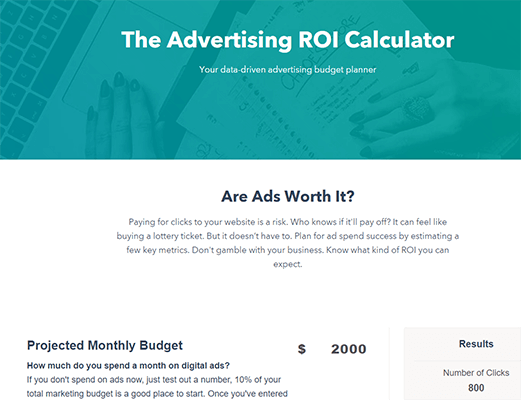Landing Page SEO: How To Rank Money Pages To Make Sales Faster

Picture this:
After following the landing page best practices and including the right visuals, you’ve built a landing page that converts.
But how do you plan to scale up traffic to the landing page?
A PPC funnel is a fantastic play for printing money. Consider this:
- The average Facebook ad cost per click (CPC) ranges between $0.22 – $1.21. For this example, I’ll use the average of $0.72.
- The median landing page conversion rate is between 2.6% and 6%. I’ll use the business consulting niche average of 5%. That means the average lead will cost $14.40 ($0.72 ÷ 0.05 = $14.40).
- Let’s also say 5% of those leads get your consulting services. This means you bought a new client for $288 ($14.40 ÷ 0.05 = $288).
- If they invest $3,000 in your services or product, that means you paid $288 for a $3,000 client. That’s a 10.4x return on ad spend (ROAS)!
What if instead of spending $288 in Facebook ads to get a $3,000 customer, you optimize your landing pages for SEO?
This is how I doubled Decibite’s annualized revenue in 6 months.
SEO may take more time to “print money” than Facebook ads. But once you’ve built the SEO flywheel, it costs no more money to get traffic every month.
Let’s say your landing page pulls in 100 people per month through SEO, which is reasonable. Instead of paying $72 for 100 Facebook clicks, you get that traffic for free. This means you’ll break even with SEO in four months.
If you build 96 landing pages as I did with Decibite, that’s $6,912/month worth of traffic at 100 clicks/month for $0.72 per click.
In this article, I’m going to share some tricks-of-the-trade to rank landing pages which get more traffic.
And if you keep reading, I’ve included a bonus to give you more tactics and strategies like this one.
Time to buckle up! This is going to be a wild ride…
Landing page SEO best practices: How the greatest rank landing pages in Google, fast
Let me start by making this simple.
If you think of a landing page to be like an article, I bet you could figure out how to rank a landing page in Google. Sure, the formatting you choose to use is likely different. And you may want to test different landing page elements.
The magic I’m going to share with you is how to find the right keywords to convert customers faster. Along the way, you’ll likely pick up some tactics on how to do landing page SEO more effectively at scale.
Principles of keyword research
So.
If you’re reading this article, I assume you know the principles of keyword research.
This means you have a basic understanding:
- What keyword phrases are (e.g. topics your customers want more information about).
- How easy or hard it is to rank a page in Google by evaluating the SERPs.
- How to prioritize keywords. If everything is equal, it’s best to rank for high conversion keywords, with high traffic potential, and easy to rank in Google.
In this article, I’ll teach you how to find high conversion, high traffic, and easy-to-rank keywords. But if you’re lost, I recommend reading, “Keyword Research: The Complete Beginner’s Guide.”
Importance of on-page SEO
You know that on-page SEO increases your odds of your page ranking in Google.
You should have a good grasp on:
- How a reader’s experience improves search traffic. Your landing page loads fast because you have a fast web host, limited plugins, and optimized images. Your content matches the reader’s search intent. And your information is thorough, useful, and readable.
- Creating content for readers and Google. Yes, you have your keyword in your H1, H2s, URL, meta description, and intro. But the content reads naturally too.
You’ll soon learn some next-level tricks to improve on-page SEO. But if this all sounds foreign to you, I recommend reading, “On-Page SEO: The Definitive Guide” and checking our roundup of on-page SEO tools.
Basics of link building to increase organic traffic
You know how to get links to increase organic traffic faster.
You may not know how to build links to landing pages because it’s a different art and science than building blog links. I’ll give you the skinny on getting landing page links.
But you should know the basics of link building. If not, I recommend reading, “The Essential Guide To Link Building Without Risking Your Rankings.”
Now that the assumptions are out of the way, I want to show you how to find high buyer-intent keywords.
Fast ways to find high buyer-intent keywords for your landing pages: Target the 5 stages of customer awareness
The greatest mistake marketers make is trying to create demand.
Eugene Schwartz
In 1966, copywriting executive Eugene Schwartz wrote “Breakthrough Advertising.” You could read this book in AD 2066 or 1066 BC, the fact is the principles of human behavior are the same.
In this book, Schwartz identified the 5 stages of customer awareness.
What are the 5 stages of customer awareness?
- Most Aware: Your customer knows your product or service, and she’s ready to buy it right now. If you give her the right reasons to buy now, like exclusive offers or relevant testimonials, she’ll sign up today.
- Product-Aware: Your customer is learning about your solution. He knows what you sell and often what the competition sells. But he’s not sure it’s right for him. You should be clear why he should buy your product rather than the competition’s product. If you’re successful, he’ll buy today.
- Solution-Aware: Your customer knows the result she wants and is reviewing solutions. But she may not know your product exists. If she does know your solution, she doesn’t know it provides the outcome she wants.
- Problem-Aware: Your customer senses he has a problem because he’s experiencing pain. But he doesn’t know what’s the right solution to the problem.
- Unaware: Even though she has a problem, your customer doesn’t know of her pain. Think of this prospect like someone who has cancer, but the doctor has not diagnosed that she has stage two melanoma skin cancer.
As a product marketer, I use the 5 stages of awareness to find high buyer-intent keywords.
Most aware customers are loyal readers of your content and likely on your email list.
Since all they need is a good reason to buy today, I use product-aware keywords to target most aware customers.
Product-aware customers are your comparison shoppers.
During the 2020 Super Bowl, Pizza Hut made a big-and-bold challenge: Get 25% bigger chicken wings.
From the “Bing it on Challenge!” to “I’m a Mac, and I’m a PC” ads, marketers have used comparison ads to help product-aware customers.
Even smaller companies and affiliate blogs are targeting comparison shoppers.
Here’s an example of Intercom comparing their product to Drift:

By applying your content marketing skills, you can educate these customers to help them decide your offer is right for them.
This is where comparative ad keywords shine. These keywords include:
- {Competitor 1} vs {Competitor 2}. Example: Ahrefs vs SEMrush.
- {Competitor} Alternative. Example: Moz Alternatives.
- {Competitor} Pricing. Example: Ahrefs Pricing.
- {Competitor} Review. Example: SEMrush Review.
- {Competitor} {Product type}. Example: Ahrefs backlink checker.
If you use your favorite SEO tool, you’ll find Intercom’s page ranking in the top 20 for a variety of keyword terms too:

Pro tip: High traffic keywords are not always harder to rank.
“Drift chat” gets 1,500 searches/month and has a keyword difficulty (KD) score of 25. “Intercom chat” has 700 searches/month and a KD score of 54. With a new site, you may find it easier to target “drift app” (KD 7), then later switch to a higher volume keyword like “drift chat.” A simple way to do this is by changing your meta title.
How should you create your comparison landing page?
My favorite approach is to create a unique selling proposition (USP), then use your USP to draw your battle lines.
Marketing a USP is largely why:
- Anacin tripled revenue from $18 million to $54 million in 18 months.
- GEICO has had the largest market share growth for nearly 20 years for auto insurance.
- President Eisenhower became the 34th President of the United States, winning 442 to 89 in the electoral vote.
This isn’t an article on creating USPs. (You can get a primer on creating USPs here). That said, this graphic on brand messaging may help you understand why USPs are powerful:

In summary, your USP comes by…
- Talking to customers and using their language to inform your brand messaging.
- Using your brand messaging to clarify your brand positioning. In simpler terms, positioning helps potential customers understand why you’re different from your competitors.
- Applying your brand positioning to your value proposition. Your value prop tells your customers the value they get when doing business with you.
- Refining your value proposition to create your USP. A value prop becomes a USP when you include a claim using a specific data point. Decibite’s USP is “Get 15% or faster web hosting, guaranteed.”
Once you have your USP, you can use that as a starting point to make your comparison.
Here’s an example of Decibite using their unique selling proposition to compare GoDaddy to Decibite with a landing page:

There are many ways Decibite could compare themselves to GoDaddy. Since the USP makes the promise of 15% faster hosting, the landing page educates the customer on how they provide faster hosting.
If you don’t have a USP, there are other opportunities to create a comparison page. After talking to their customers, Teachable customers were switching to Podia because their software had bugs. So Podia made this comparison to Teachable:

This approach to keyword research works well for regular blog content too.
Is your blog getting traffic, but you’re lacking leads or sales? Try creating content for product-aware prospects.
Login Lockdown reviews different password manager tools. Here’s an article they did to compare LastPass to 1Password:

Let’s say you’ve created landing pages for each of your competitors. The next step is to create landing pages that target solution-aware keywords and customers.
Solution-aware customers are looking to learn more about what you can do to solve their problems.
Solution-aware prospects know the solution they need. As a result, the next type of landing page to rank in Google should describe the solutions you offer.
If you offer a service, I recommend you create a landing page that describes what you do to solve your customer’s problems. Here’s an example from Powered By Search, who has a marketing service page:

They do an excellent job clearly stating who their customer is (B2B SaaS). They also offer two call-to-action options:
- Schedule a free session, which is helpful for prospects almost ready to become a customer.
- Check out their monthly recurring revenue (MRR) calculator. This helps prospects who are problem-aware and stumbled on the wrong page.
I also recommend you provide a mini case study. This helps your clients know you can deliver on the solution they want to achieve. Here’s an example from Elumynt using case studies on their PPC service page:

Finally, if you offer many services, you can create a dedicated page for each service. For example, Blueprint Digital has a dedicated landing page for their SEO services:

If you sell a product, how do you create landing pages for solution-aware customers?
A common opportunity here is to target product keywords related to your product’s features.
Let’s say you want high-performance web hosting to speed up your website. A customer who’s aware of the solution they want would go to Google and look up “high-performance web hosting.”
When you do so, you may find Decibite’s page on high-performance hosting:

Here’s another example.
Close CRM has a power dialer to automate sales calls. When a sales rep looks for a power dialer built inside their sales CRM, they will find this page:

Once you’re done with solution-aware customers, it’s time to serve problem-aware customers.
Problem-aware customers need help understanding what’s the solution to their problem.
Prospects who are problem-aware typically made a transition in their life. She may have started a new hobby, got promoted as the director of marketing, or became a freelancer.
With her new lifestyle change comes new problems. Unfortunately, she’s unaware of what will soothe her pain.
As a director of marketing, she may not know whether ads are a worthwhile marketing channel. So she goes to Google and types in “Ads ROI calculator.” As a result, she comes across this advertising ROI calculator from Hubspot:

Traditional content marketing also plays an important role to help problem-aware prospects.
That includes creating podcasts, YouTube videos, articles, and other more top-of-funnel content.
Prospects who are completely unaware, you may be better ignoring them.
As a general rule-of-thumb, completely unaware customers take a lot of work to convert. And it can be expensive to do so.
Because before you even sell them on a solution, you need to educate them that they have a problem. Once you’ve helped them realize their pain, you can tell them about a solution. Finally, after explaining a solution, you need to show social proof to get them to buy from you.
Because unaware customers are harder to convert, perhaps this is why I’ve never seen a landing page for them. So let’s look at an example from an article for completely unaware prospects.
Wordstream is a PPC tool and agency. They wrote an article about five digital marketing skills:

This topic isn’t directly relevant to PPC. But perhaps someone who wants to improve their digital marketing skills may want to improve their PPC skills. Someone who wants to improve their PPC skills may use a PPC tool. And if they want a PPC tool, they may find Wordstream is the right tool for the job.
Completely unaware keywords take a longer time to make a sale, but it can work in the right circumstances.
BONUS: Local landing pages – How to rank local city pages in SEO
Love it or hate it, some customers love buying local. And there’s evidence local searches have a higher chance of buying.
According to a study by Think with Google, 18% of local smartphone searches led to a purchase in a day. When you compare that to 7% of non-local searches leading to a sale, that’s an extra 157% more sales!

Perhaps you’re thinking, “I serve national and international clients. Why should I create local pages?”
A customer may not care if you’re local. More often than not, they want the problem solved.
If you had cancer and the doctor promises to cure you of cancer in 30 days, do you care if he does it through his webcam? Probably not.
Uber has a dedicated page for every city they’re in. Here’s what their page looks like for my city of Spokane:

Thrive is a marketing agency. Their headquarter office is in Texas, yet they’ve got local city pages for Miami, Seattle, Portland, and 22 other cities. Here’s an example of their Seattle page:

If you’re not in a specific location, there’s a fine line you need to walk to represent the truth. One way to keep you honest is to showcase case studies from clients in specific cities.
I’ve built my landing pages optimized for SEO. Now what?
SEO can be a game of hurry-up-and-wait.
If you have a fast landing page, your keywords are easy-to-rank, and your content matches the customer awareness stage, it’s easier to rank faster.
Building landing page links tend to be harder, but still possible. Aside from internally linking pages on your website to the landing page, I recommend doing guest posts. If you write about what you did to those landing pages, you can use them as an example in your article.
Of course, PPC and SEO are not mutually exclusive. Now you know how to start the SEO flywheel, you can use PPC to build speed faster.
The SEO traffic is slower, but free. The PPC traffic is faster, but costs more money. Put the two together and you’ve found a match made in heaven.
With two flywheels spinning, it becomes that much easier to create a funnel that scales with your business.

